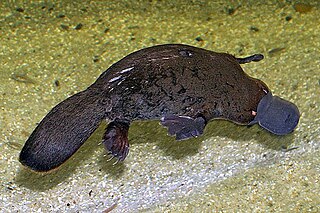
The Ornithorhynchidae are one of the two extant families in the order Monotremata, and contain the platypus and its extinct relatives. The other family is the Tachyglossidae, or echidnas.

Papagomys is a genus of very large rats in the tribe Rattini of the subfamily Murinae, with body masses of 600–2,500 grams (1.3–5.5 lb). It contains two species, which are known only from the Indonesian island of Flores:

The Old World rats and mice, part of the subfamily Murinae in the family Muridae, comprise at least 519 species. Members of this subfamily are called murines. In terms of species richness, this subfamily is larger than all mammal families except the Cricetidae and Muridae, and is larger than all mammal orders except the bats and the remainder of the rodents.

The rakali, also known as the rabe, the "Australian Otter" or water-rat, is an Australian native rodent first scientifically described in 1804. Adoption of the Ngarrindjeri name rakali is intended to foster a positive public attitude by Environment Australia.
The earless water rat is a New Guinea rodent, part of the Hydromys group of the subfamily of Old World rats and mice (Murinae). It is the only species in the genus Crossomys. This species is probably most closely related to Baiyankamys. It is still unclear to which species this group is related. It is one of the most aquatically adapted rodents of the world.

Leptomys is a genus of rodent endemic to New Guinea. It is considered part of the New Guinea Old Endemics, meaning it was part of the first wave of murine rodents to colonize the island. Leptomys are seen to have minimal adaptations to their aquatic life style. Elongated hind feet accompanied by elongated centre toes suggest the ability to leap. The third molar which is lost is many rodents is retained, albeit smaller. Small eyes and ears can be seen amongst its velvety soft fur.
The mountain water rat is a semiaquatic species of rodent in the family Muridae. It is found in West Papua, Indonesia and Papua New Guinea. Its natural habitat is rivers.
The western water rat is a semiaquatic species of rodent in the family Muridae. It is found in West Papua, Indonesia and Papua New Guinea. It is threatened by habitat loss however a lot is still unknown about the species and it has been classified as Data Deficient on the IUCN Red List.
The New Britain water rat is a species of semiaquatic rodent in the family Muridae. It is found only on the island of New Britain in Papua New Guinea. It is threatened by habitat loss.
Shaw Mayer's water rat is a semiaquatic species of rodent in the family Muridae. It is found in the mountains of Papua New Guinea.

The long-footed water rat is a species of rodent in the family Muridae. It is found in the mountains of southern Papua New Guinea. Its natural habitat is subtropical or tropical dry forest.

Ernst Mayr's water rat is a species of rodent in the family Muridae, named for evolutionary biologist Ernst Mayr. It is found in the Foja Mountains of Papua Province, Indonesia, and in the mountains of northeastern Papua New Guinea.
The red-bellied mosaic-tailed rat is a species of rodent in the family Muridae. It is the only species in the genus Protochromys. It is found only in Papua New Guinea.

The northern water rat is an endangered species of rodent in the family Muridae found in the highlands of New Guinea.

The short-haired water rat is a species of rodent in the family Muridae. It is found in West Papua, Indonesia and Papua New Guinea. There are two currently undescribed species allied with this taxon.

The New Guinean rat is a species of rodent in the family Muridae. It is found only in parts of central Papua New Guinea.

Xeromys myoides, also known as the water mouse, marine mouse, mangrove mouse, false water rat, manngay and yirrkoo, is a species of rodent native to waterways of Australia and Papua New Guinea.
German's one-toothed moss mouse is a species of rodent in the family Muridae which occurs in the mountains of southeastern New Guinea.

Baiyankamys is a genus of amphibious murid rodents. It was originally described, along with the species Baiyankamys shawmayeri by Hinton in 1943 after he found the remains of a single individual in south east of the Bismarck Mountain Range, north east New Guinea. Tate, in 1951 and, Laurie and Hill in 1954, confirmed the existence of both the species and genus.

Hydromyini is a very large, diverse tribe of muroid rodents in the subfamily Murinae. They are the dominant native rodents in Australasia and one of only two native rodent groups there, the other being the R. fuscipes group of the genus Rattus in the tribe Rattini. They are also found in parts of Southeast Asia.










